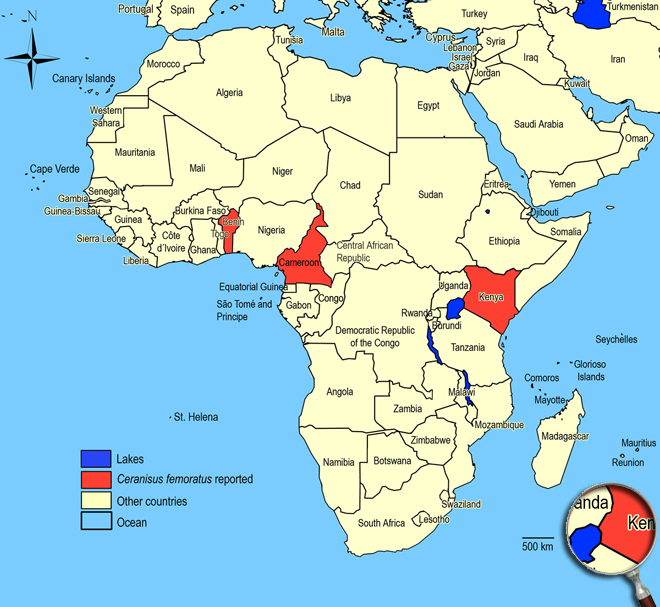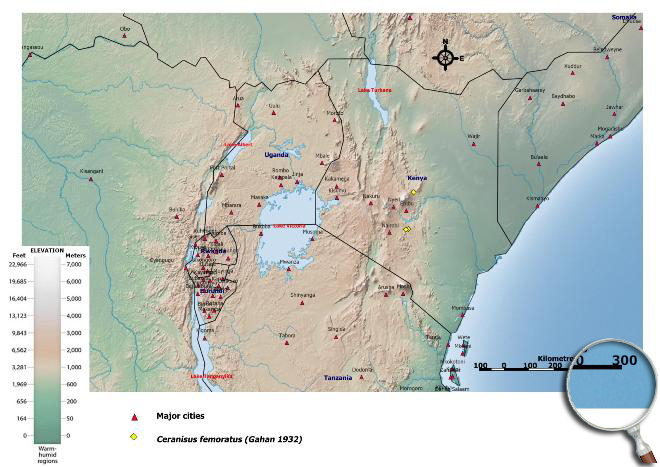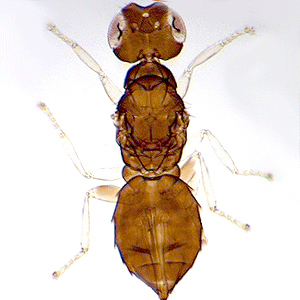Ceranisus femoratus (Gahan, 1932)
Entedoninae, Eulophidae, Chalcidoidea, Hymenoptera
Figures
Fig. 1: Head, mesosoma and metasoma, dorsal
Fig. 2: Antenna
Fig. 3: Funicle segments and clava of antenna
Fig. 4: Funicle segments
Fig. 5: Head dorsal with vertexal suture
Fig. 6: Mesosoma dorsal with mesoscutum and scutellum
Fig. 7: Fore wing
Fig. 8: Metasoma
Fig. 9: Petiole
Introduction and recognition
Ceranisus femoratus is a larval endoparasitoid of thrips belonging to the genus Megalurothrips (Megalurothrips sjostedti, Megalurothrips usitatus - family Thripidae). Female: length about 1 mm. Body, coxae, and femora dark brown, basal terga of gaster sometimes a little, but not contrastingly, lighter (brown); antenna, tibiae and tarsi pale to light brown. Some of the specimens collected in Kenya show variability with an all brown gaster and all pale legs except the coxa (Fig. 1 and 8). On head vertexal suture angulate (broadly Y-shaped); frontal grooves reaching eye at level of anterior (median) ocellus; malar sulcus present, entire and straight (Fig. 5). Antenna with scape slightly broadened medially, about 4.4 x as long as wide; 2 funicle segments subequal, F1 and F2 a little longer than wide and with 1 or 2 sensilla; 2-segmented clava about 1.7-2.0 x as long as wide, its distal segment about 2 x as long as basal claval segment; distal segment with distinct apical spicula (Fig. 2, 3 and 4). Mesosoma shorter than gaster, almost smooth; midlobe of mesoscutum with 2 pairs of setae; anterior margin of scutellum straight (Fig. 6). Fore wing broadened beyond submarginal vein, about 2.4 x as long as wide; longest marginal setae about 1/4 maximal width of fore wing; disc hyaline, with numerous short setae, more or less uniformly setose beyond base of marginal vein except for a narrow bare area along posterior margin behind base of marginal vein, which is demarcated anteriorly by a more or less straight cubital setal line; postmarginal vein slightly longer than stigmal vein (Fig. 7). Hind wing about 6 x as long as wide; longest marginal setae about 0.7 x its maximal width. Petiole about 2 x wider than long (Fig. 9). Ovipositor occupying 3/5-7/10 length of gaster; barely exerted or not; ovipositor length/metatibia length ratio about 1.6:1 (Fig. 8).
Male unknown.
Taxonomic identity
Species
Ceranisus femoratus (Gahan, 1932)
Synonyms
Thripoctenus femoratus Gahan, 1932
Present taxonomic position
Order: Hymenoptera
Superfamily: Chalcidoidea Latreille, 1817
Family: Eulophidae Westwood, 1829
Subfamily: Entedoninae Förster, 1856
Genus: Ceranisus Walker, 1842
Genus description
The Genus Ceranisus Walker, 1842
This genus comprises about 22 described species. All known species of Ceranisus are solitary, internal parasitoids of the larval stages of various Thripidae (Terebrantia), and have worldwide distribution. All species of the genus have the following features: Body colour yellow to dark brown or black; head usually with a more or less distinct occipital suture (straight, sinuate or angulate) across vertex just behind posterior ocelli, frontal grooves reaching eye at level of anterior (median) ocellus; malar sulcus present, entire and straight in most species; mandible reduced and without teeth; flagellum of female antenna with 2 funicle segments and a distinct 2- or rarely 3-segmented clava; male antenna often with a swollen scape, male flagellum with funicle 2-segmented and clava 3-segmented; apical claval segment with an apical spicula in both sexes; notauli usually indistinct, sometimes distinct but faint; midlobe of mesoscutum almost always with 2 pairs of setae (except with 1 such pair in most Ceranisus russelli); anterior margin of scutellum straight; fore wing broadened beyond submarginal vein, longest marginal setae at most equal to (usually much less than) width of fore wing; petiole at most as long as wide, usually notably wider than long (Schauff 1991; Triapitsyn 2005). Triapitsyn & Headrick (1995) reviewed the Nearctic species of Ceranisus; Triapitsyn & Morse (2005) revised the New World fauna of the genus. Triapitsyn (2005) gave a world taxonomic revision of Ceranisus and three other related entedonine genera of thrips parasitoids, and Loomans & van Lenteren (1995) provided an overview of the described thrips parasitoids and their importance for biological control of thrips pests.
Species description
Typical character states of Ceranisus femoratus
Body color
Uniformly light to dark brown
Antennae
Funicle segments F1 and F2: subequal
Sensilla of funicle segments: each segment with 1 or 2 short sensilla
Length of funicle segments: markedly longer than wide
Clava of female: 2-segmented
Apical spicula of clava: present
Head
Vertexal suture: angulate (broadly Y-shaped)
Frontal grooves: reaching eye at level of anterior (median) ocellus
Mesosoma
Number of setal pairs on midlobe of mesoscutum: 2
Anterior margin of scutellum: straight
or slightly curved
Wings
Shape of fore wing: broadened beyond submarginal vein
Length of fore wing: 2.4 to 3.0 x as long as wide
Length of fore wing marginal setae: usually much less than width of fore wing
Longest marginal setae of fore wing: 1/4 to 1/3 maximal width of fore wing
Fore wing disc: more or less uniformly setose beyond base of marginal vein except for a narrow bare area along posterior margin behind base of marginal vein, which is demarcated anteriorly by a straight cubital setal line
Colour of fore wing disc: completely hyaline, without pigmentation
Metasoma
Colour of gaster: completely light to dark brown
Petiole: notably and about 2 x wider than long

Similar or related species
The species differs from Ceranisus menes in having the gaster completely brown to dark brown, a vertexal suture that is notably angulate and broadly Y-shaped, a fore wing disc with a narrow bare area along posterior margin behind base of marginal vein, which is demarcated anteriorly by a more or less straight cubital setal line, and a petiole that is about 2 x wider than long. Whereas in Ceranisus menes the gaster is completely yellow to light brown or at least basally yellow to light brown and distally dark brown, the vertexal suture is straight, the fore wing disc has a distinct semi-oval bare area at posterior margin behind base of marginal vein, demarcated anteriorly by a sinuate line of setae, and the petiole is almost as wide as long.
Ceranisus and other genera differs from Goetheana by the shape of the antennal funicle segments (in Goetheana funicle segment F1 is much smaller than F2, F2 almost fused with clava; in other genera the funicle segments F1 and F2 are subequal), the shape of the fore wing (narrow and recurved below the submarginal vein in Goetheana; species of the genera Entedemophale, Ceranisus and Thripobius with fore wings broadened beyond submarginal vein), and the length of marginal seta of fore wing (in Goetheana the longest marginal setae much greater than width of fore wing; other genera with longest marginal setae at most equal to width of fore wing, but usually much less than width of fore wing). The chaetotaxy of the fore wing disc differs in the genera: in Goetheana the setae commences beyond base of marginal vein and scattered in 2 or 3 broken rows toward the apex of the wing, in Entedemophale the fore wing is evenly setose in apical half and bare in basal half, and in Ceranisus and Thripobius the fore wing is uniformly setose beyond base of marginal vein except for a bare area at posterior margin behind base of marginal vein, which is demarcated anteriorly by a sinuate or straight line of setae. Compared to Entedemophale, species of Ceranisus and Thripobius have the antennal clava of females distinctly segmented (Thripobius with 3-segmented and Ceranisus with 2-segmented clava), and the apical spicula of clava is present. Whereas in Entedemophale the antennal clava of females is unsegmented and without apical spicula. Entedemophale as well as Thripobius have an inverted Y-shaped malar sutures (in Ceranisus entire and straight). Compared to species of Ceranisus, in Thripobius antennal funicle segments F1 has 1 long sensillum, F2 no sensilla, on head the malar sulcus is split ventrally, the frontal grooves reaching eyes above level of median ocellus, sometimes ending in vertexal suture, the midlobe of mesoscutum has 0 or 1 pair of setae. Whereas in Ceranisus each antennal funicle segment has 1 or 2 short sensilla, on head malar sulcus is entire and straight, the frontal grooves reaching eyes at level of anterior (median) ocellus, the midlobe of mesoscutum has 2 pairs of setae.
Biology
Life history
Ceranisus femoratus reproduces by thelytokous parthenogenesis, and deposits only one egg per thrips larva. The average developmental duration from egg to adult was 19 days (Agboton et al. 2005).
Major host genera/species
Megalurothrips (Megalurothrips sjostedti, Megalurothrips usitatus).
Ceranisus femoratus is closely associated with the bean flower thrips, Megalurothrips sjostedti, on crops like hyacinth bean and red gram.
Additional notes
In Cameroon the species was discovered in 1998. The parasitism rates of Ceranisus femoratus both on cultivated and wild growing legumes averaged above 20%, compared with less than 1% parasitism inflicted by the indigenous species Ceranisus menes (Neuenschwander & Markham 2001; Tamò et al. 2002). Ceranisus femoratus was successfully introduced from Cameroon to Benin against Megalurothrips sjostedti; also attempts were made to introduce it to Ghana. However in Ghana successful establishment was not observed for this parasitoid (Tamò et al. 2003; Tindo 2001). The parasitism percentage of this parasitoid on Megalurothrips sjostedti in Benin was found to vary from 15.3 - 60% depending upon the host and the season (Fatokun et al. 2002).
Biogeography
Oriental regions (Africa, India, and the Philippines). Benin, Cameroon, Kenya (Meru and Yatta regions).
African countries where Ceranisus femoratus has been reported

Occurence of Ceranisus femoratus in East Africa

Click here for locations of Ceranisus femoratus in parts of East Africa.
Please
click here for survey sites of all observed thrips species of Kenya, Tanzania and Uganda.

Bibliography
Agboton C (2004). Potentialités biologiques et écologiques de Ceranisus femoratus (Gahan) (Hymenopzera: Eulophidae) un nouvel ennemi naturel pour lutter contre Megalurothrips sjostedti (Trybom) (Thysanoptera: Thripidae) ravageur du niébé au Bénin. Thèse pour ľobtention du Diplôme ďEtudes Approfondies (DEA). UAC, 95 pp
Agboton C, Atachi P & Tamò M (2005). Etude experimentale de quelques parametres biologiques Ceranisus femoratus (Gahan) (Hymenoptera: Eulophidae) un nouvel ennemi naturel pour le controle de Megalurothrips sjostedti (Trybom) (Thysanoptera: Thripidae) ravageur du niebe au Benin. Annales des Sciences Agronomiques. 7 (1)
Baltazar CR (1966). A catalogue of Philippine Hymenoptera (with a bibliography, 1758-1963). Pacific Insects Monograph.8: 1-48
Bouček Z (1976). Taxonomic studies on some Eulophidae [Hym.] of economic interest mainly from Africa. Entomophaga. 21(4): 401-414
Doğanlar M, Gumovsky A & Doğanlar O (2009). A new species of the menes species group of the genus Ceranisus (Hymenoptera: Eulophidae) from Turkey. Türkiye Entomoloji Dergisi. 33 (4): 265-278
Doğanlar M & Triapitsyn SV (2007). Review of Ceranisus (Hymenoptera: Eulophidae) of Turkey, with description of a new species. European Journal of Entomology. 104 (1): 105-110
Fatokun CA, Tarawali SA, Singh BB, Kormawa PM & Tamò M [eds.] (2002). Challenges and opportunities for enhancing sustainable cowpea production. Proceedings of the World Cowpea Conference III held at the International
Institute of Tropical Agriculture (IITA), Ibadan, Nigeria, 4-8 September 2000. IITA,
Ibadan, Nigeria
Gahan AB (1932). Miscellaneous descriptions and notes on parasitic Hymenoptera. Annals of the Entomological Society of America. 25 (4): 736-757
Gibson, G.A.P., Read, J.D. & Fairchild, R. 1998. Chalcid wasps (Chalcidoidea): illustrated glossary of positional and morphological terms
Loomans AJM, Murai T & Green ID (1997). Interactions with hymenopterous parasitoids and parasitic nematodes, pp. 355-397. In Lewis T [ed.], Thrips as crop pests. CAB International, Wallingford, Oxon, UK
Loomans AJM & van Lenteren JC (1995). Biological control of thrips pests: a review on thrips parasitoids, pp. 89-201. In Loomans AJM, van Lenteren JC, Tommasini MG, Maini S & Riudavets J [eds.], Biological control of thrips pests. Wageningen Agricultural University Papers, 95-1. Veenman Drukkers, Wageningen, The Netherlands
Ndam H (1998). Dynamique de population de deux insèctes ravageurs (Megalurothrips sjostedti et Maruca vitrata) du niébé au Sud Cameroun et leurs enemies naturels. Mémoire de fin ďétude ďingénieur agronome Université de Dschang, 39 pp.
Neuenschwander P & Markham R (2001). Biological control in Africa and its possible effects on biodiversity, pp. 127-146. In Wajnberg E, Scott JK & Quimby PC [eds.], Evaluating indirect ecological effects of biological control. CABI Publishing, Wallingford, UK
Schauff M (1991). The Holarctic genera of Entedoninae (Hymenoptera: Eulophidae). Contributions of the American Entomological Institute. 26 (4): 1-109
Tamò M, Arodokoun DY, Zenz N, Tindo M, Agboton C & Adeoti R (2002). The importance of alternative host plants for the biological control of two key cowpea insect pests, the pod borer Maruca vitrata (Fabricius) and the flower thrips Megalurothrips sjostedti (Trybom), pp. 81-93. In Fatokun CA, Tarawali SA, Singh BB, Kormawa PM, & Tamò M [eds.], Challenges and opportunities for enhancing sustainable cowpea production. Proceedings of the World Cowpea Conference III held at the International Institute of Tropical Agriculture (IITA), Ibadan, Nigeria, 4-8 September 2000. IITA, Ibadan, Nigeria
Tamò M, Baumgärtner J, Delucchi V & Herren R (1993). Assessment of key factors repsonsible for the pest status of the bean flower thrips Megalurothrips sjostedti (Thysanoptera: Thripidae) in West Africa. Bulletin of Entomological Research. 83 (2): 251-258
Tamò M, Ekesi S, Maniania NK & Cherry A (2003). Biological control, a non obvious component of Integrated Pest Management for Cowpea. pp. 295-309, In: Neuenschwander, C., Borgemeister, C., Langewald, J. (eds.). Biological Control in Integrated Pest Management Systems in Africa. CAB International, Wallingford
Tindo M (2001). Survey on insects associated with selected legume cover crops in the forest zone of southern Cameroon. CIEPCA Newsletter. 7: 5-6
Triapitsyn SV (2005). Revision of Ceranisus and the related thrips-attacking entedonine genera (Hymenoptera: Eulophidae) of the world. African Invertebrates. 46: 261-315
Triapitsyn SV & Headrick DH (1995). A review of the Nearctic species of the thrips-attacking genus Ceranisus Walker (Hymenoptera: Eulophidae). Transactions of the American Entomological Society. 121 (4): 227-248
----
Web links
BMNH, Universal Chalcidoidea Database
UC Riverside - Key to the Nearctic genera of Eulophidae
Mound´s Thysanoptera pages
Thysanoptera Checklist
ICIPE Thrips survey sites
UNI Halle & Thrips sites
Thrips of California
Chalcid wasps (Chalcidoidea): illustrated glossary of positional and morphological terms
Assembling the Tree of Life - Hymenopera Glossary













